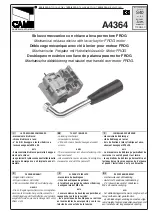
10
• The objective is to make the parts fit closely together. Maximize the gluing surface by making the tenon as long as possible
(approximately 1/2 the width of the stile or longer, if using narrow stock). Balance the joint by using the same amount of
wood in the tenon as in the combined thickness of the mortise walls (Fig. 26). If one piece of wood is larger than the other,
make the tenon as thick as possible (Fig. 27).
• Remember to figure the kerf of the saw blade when setting up for the cut.
• Cut all mortises first. Make the mortise 1/16" deeper than the length of the tenon to allow for glue.
2. Make a spacer block of wood (K) Fig. 28, equal to the
thickness of the tenon plus the thickness of the saw
blade.
3. With the tenoning jig (H) Fig. 28 located at the front of
saw table and over the base stop (F), load the spacer
block (K) and the workpiece (L). Securely clamp both in
place with the clamp handle (M). Make certain that both
pieces of wood are against the vertical support plate
(N) and the backup board (P).
4. Gently push the tenoning jig (H) Fig. 28 toward the saw
blade until workpiece is near the saw blade. Adjust the
tenoning jig (H) and the saw blade to make the first
cheek cut. Return the tenoning jig (H) to the front of saw
table.
5. Connect the saw to the power source.
6. Turn the saw “ON” and perform the first structural
cheek cut (Fig. 29). Feed the tenoning jig toward the
saw blade at a slow feed rate until the saw blade has
exited the back of the workpiece. Turn the tool off
and allow the blade to come to a complete stop, then
slowly pull the tenoning jig back to the position shown
in Fig. 28.
Fig. 26
Fig. 27
Fig. 28
You can use several different methods to cut a mortise and tenon. The following information illustrates one of the easiest and
safest methods and utilizes cheek cuts first, then shoulder cuts. Use a base stop (F) Fig. 28 that is the same thickness as the
base plate (G) of the tenoning jig (H) and spacer block (K) that is the combined thickness of the tenon and the saw blade,
to make the cutting more efficient. This method eliminates possible errors caused by thickness variations in the workpiece,
and avoids trapping cut-off pieces between the saw blade and vertical support plate (N).
NOTE: Perform your practice cuts on scrap material before cutting good wood.
Use a slow feed rate to help prevent the tenoning jig from lifting during a cut
.
Keep your hands on the jig handles when performing cuts.
Fig. 29
F
K
L
P
M
N
H
G
1. Clamp a base stop (F) Fig. 28 (the same thickness as the base plate (G) of the tenoning jig (H)) on the front of the saw
table. This will allow tenoning jig to pass over the base stop (F).

































